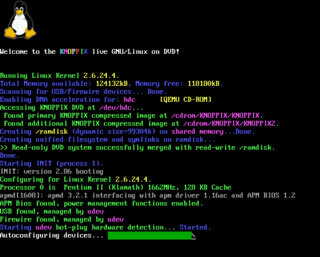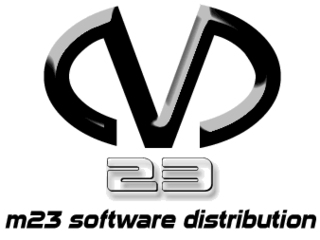Related Research Articles

AIX is a series of proprietary Unix operating systems developed and sold by IBM for several of its computer platforms.

The IBM System p is a high-end line of RISC (Power)/UNIX-based servers. It was the successor of the RS/6000 line, and predecessor of the IBM Power Systems server series.
In telecommunication, provisioning involves the process of preparing and equipping a network to allow it to provide new services to its users. In National Security/Emergency Preparedness telecommunications services, "provisioning" equates to "initiation" and includes altering the state of an existing priority service or capability.
Journaled File System (JFS) is a 64-bit journaling file system created by IBM. There are versions for AIX, OS/2, eComStation, ArcaOS and Linux operating systems. The latter is available as free software under the terms of the GNU General Public License (GPL). HP-UX has another, different filesystem named JFS that is actually an OEM version of Veritas Software's VxFS.
Internet Small Computer Systems Interface or iSCSI is an Internet Protocol-based storage networking standard for linking data storage facilities. iSCSI provides block-level access to storage devices by carrying SCSI commands over a TCP/IP network. iSCSI facilitates data transfers over intranets and to manage storage over long distances. It can be used to transmit data over local area networks (LANs), wide area networks (WANs), or the Internet and can enable location-independent data storage and retrieval.

One meaning of system console, computer console, root console, operator's console, or simply console is the text entry and display device for system administration messages, particularly those from the BIOS or boot loader, the kernel, from the init system and from the system logger. It is a physical device consisting of a keyboard and a printer or screen, and traditionally is a text terminal, but may also be a graphical terminal. System consoles are generalized to computer terminals, which are abstracted respectively by virtual consoles and terminal emulators. Today communication with system consoles is generally done abstractly, via the standard streams, but there may be system-specific interfaces, for example those used by the system kernel.

In computing, the Preboot eXecution Environment, PXE specification describes a standardized client–server environment that boots a software assembly, retrieved from a network, on PXE-enabled clients. On the client side it requires only a PXE-capable network interface controller (NIC), and uses a small set of industry-standard network protocols such as DHCP and TFTP.
IBM Storage Protect is a data protection platform that gives enterprises a single point of control and administration for backup and recovery. It is the flagship product in the IBM Spectrum Protect family.

DRBL is a NFS-/NIS server providing a diskless or systemless environment for client machines.

IBM Web-based System Manager (WSM) is a management software (GUI) for administering AIX 5L host on RS/6000 systems, it can be run in standalone mode or in a client-server environment.
EMC NetWorker is an enterprise-level data protection software product from Dell EMC that unifies and automates backup to tape, disk-based, and flash-based storage media across physical and virtual environments for granular and disaster recovery.
Veritas Backup Exec is a data protection software product designed for customers with mixed physical and virtual environments, and who are moving to public cloud services. Supported platforms include VMware and Hyper-V virtualization, Windows and Linux operating systems, Amazon S3, Microsoft Azure and Google Cloud Storage, among others. All management and configuration operations are performed with a single user interface. Backup Exec also provides integrated deduplication, replication, and disaster recovery capabilities and helps to manage multiple backup servers or multi-drive tape loaders.

m23 is a software distribution and management system for the Debian, Ubuntu, Kubuntu Linux, Xubuntu, Linux Mint, elementary OS, Fedora, CentOS and openSUSE distributions.
Windows Vista contains a range of new technologies and features that are intended to help network administrators and power users better manage their systems. Notable changes include a complete replacement of both the Windows Setup and the Windows startup processes, completely rewritten deployment mechanisms, new diagnostic and health monitoring tools such as random access memory diagnostic program, support for per-application Remote Desktop sessions, a completely new Task Scheduler, and a range of new Group Policy settings covering many of the features new to Windows Vista. Subsystem for UNIX Applications, which provides a POSIX-compatible environment is also introduced.

nmon is a computer performance system monitor tool for the AIX and Linux operating systems. The nmon tool has two modes a) displays the performance stats on-screen in a condensed format or b) the same stats are saved to a comma-separated values (CSV) data file for later graphing and analysis to aid the understanding of computer resource use, tuning options and bottlenecks.
PowerVM, formerly known as Advanced Power Virtualization (APV), is a chargeable feature of IBM POWER5, POWER6, POWER7, POWER8, POWER9 and Power10 servers and is required for support of micro-partitions and other advanced features. Support is provided for IBM i, AIX and Linux.

IBM Power Systems is a family of server computers from IBM that are based on its Power processors. It was created in 2008 as a merger of the System p and System i product lines.

The Slurm Workload Manager, formerly known as Simple Linux Utility for Resource Management (SLURM), or simply Slurm, is a free and open-source job scheduler for Linux and Unix-like kernels, used by many of the world's supercomputers and computer clusters.

Distributed Data Management Architecture (DDM) is IBM's open, published software architecture for creating, managing and accessing data on a remote computer. DDM was initially designed to support record-oriented files; it was extended to support hierarchical directories, stream-oriented files, queues, and system command processing; it was further extended to be the base of IBM's Distributed Relational Database Architecture (DRDA); and finally, it was extended to support data description and conversion. Defined in the period from 1980 to 1993, DDM specifies necessary components, messages, and protocols, all based on the principles of object-orientation. DDM is not, in itself, a piece of software; the implementation of DDM takes the form of client and server products. As an open architecture, products can implement subsets of DDM architecture and products can extend DDM to meet additional requirements. Taken together, DDM products implement a distributed file system.
References
- ↑ "NIM from A to Z in AIX 5L" (PDF). IBM Redbooks. Retrieved 17 June 2016.
- ↑ "Network Installation Management". www.ibm.com. IBM. Retrieved 17 June 2016.
- ↑ Long, Lyle N.; Morris, Philip J.; Morooney, Kevin; Kellogg, Steve (December 1998). "The Teaching and Learning of High Performance Computing". Journal of Engineering Education. 87 (S5): 591–597. doi:10.1002/j.2168-9830.1998.tb00397.x. S2CID 108640218.
- ↑ Nemeth, Evi (2010). UNIX and Linux System Administration Handbook. Pearson Education. p. 380. ISBN 9780131480056 . Retrieved 18 June 2016.
- ↑ Michael, Randal (2002-12-06). AIX 5L Administration. McGraw Hill Professional. p. 112. ISBN 9780072228410.
- ↑ Preston, W. Curtis (2007-01-03). Backup & Recovery: Inexpensive Backup Solutions for Open Systems. "O'Reilly Media, Inc.". p. 375. ISBN 9780596555047.
- ↑ Racherla, Sangam; Demarchi, Delmar; Dybas, Scott; Stark, Bobby; Syed, Mansoor; Redbooks, I. B. M. (2012-09-30). SAN Boot Implementation and Best Practices Guide for IBM System Storage. IBM Redbooks. p. 374. ISBN 9780738437064.
- ↑ Milberg, Kenneth (10 February 2016). "Integrating IBM AIX's NIM and SUMA". SearchITChannel. Retrieved 18 June 2016.
- ↑ "unixwerk: NIM Commands". www.unixwerk.eu. Unixwerk. Retrieved 18 June 2016.